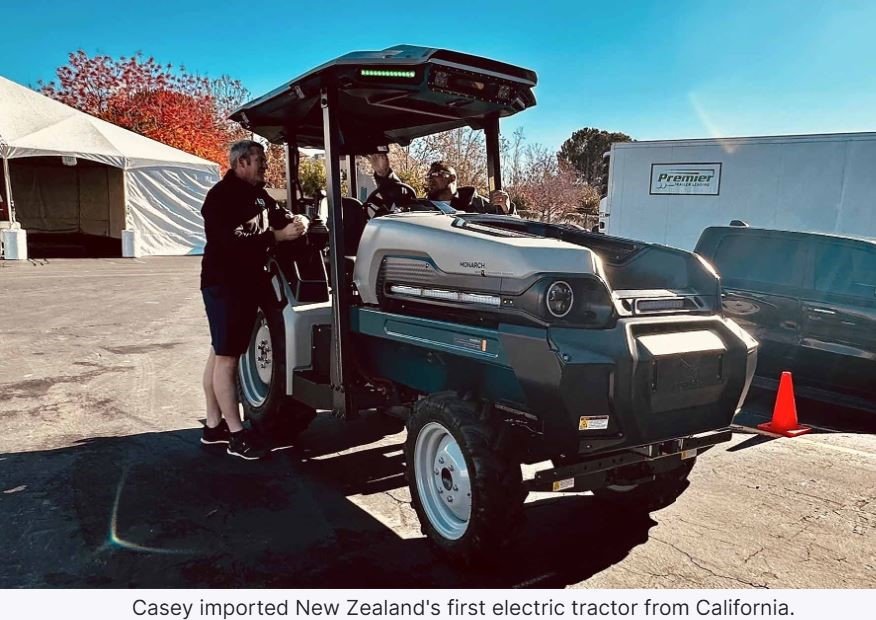Agrifutures EvokeAg - Brisbane 2025
Familiar challenges, innovative solutions
The Agrifutures EvokeAg 2025 conference occurred in Brisbane, drawing nearly two thousand delegates from various agriculture industry sectors.
Among them was Jen Riseley, who attended the event through a producer-supported position with the Department of Primary Industries and Regional Development (DPIRD). Jen was eager to reflect on her experiences and insights from this dynamic gathering.
It’s Electrifying
Mike Casey of Rewiring Aotearoa is a cherry producer from New Zealand who transitioned his 9,300-tree orchard to be fully electric. Using convenient and timely government grants, Mike was able to import energy solutions, including electric frost fans from South Africa, a Monarch electric tractor from California, and an electric motor for his sprayer to move away from a PTO, which drained the battery too quickly. The farm now generates more electricity than it uses and can sell power. Mike has hosted many Australian producers to his orchard and welcomes those wanting to learn more.
https://switchedon.reneweconomy.com.au/content/from-running-the-worlds-first-electric-cherry-orchard-to-helping-electrify-new-zealand
Reduced Carbon Emissions
Tom Norman, a fifth-generation farmer from NSW making green ammonia on-farm.
Agriculture is facing new challenges in the climate space. Both government and industry bodies are setting targets for reducing carbon emissions in Australian agriculture.
In broadacre cropping, fertiliser input is the single biggest contributor to scope 3 carbon emissions, representing up to 22.5% of total emissions. If we can switch to green anhydrous ammonia that is carbon neutral, we can reduce our carbon emissions by up to 15% through that one change alone.
https://www.evokeag.com/meet-the-jump-rope-champion-reimagining-australian-fertiliser/
Eat like a fish
Bren Smith a former commercial fisherman from Newfoundland who developed an open-source method of farming oysters and shellfish using kelp and avoiding the polluting effects of intensive fish farms. After navigating the hype curve when speculative investors pumped interest in similar projects and fled when the bubble burst, Bren formed Greenwave. This network aims to grow more kelp for environmental benefit, agricultural and pharmaceutical use and avoids institutional hype or carbon credit style schemes. Bren’s environmental message was simple, no one is coming to save us, expect self-rescue.
https://medium.com/thebeammagazine/bren-smith-the-fisherman-shaping-the-future-of-sustainable-ocean-farming-e3217835e274
Sustainability by injection
Drugs like Ozempic cost $1,000/month, require the user to inject themselves and have unpleasant side effects including vomiting and diarrhoea. Nonetheless, 10% of the US population are now using them primarily for weight loss. Research shows users will gradually change their diet to consume less food, especially avoiding ultra-processed foods and this could have an impact on US producers growing the requisite corn, wheat and soy. Speaker Jack Bobo estimated Americans could reduce their intake of these foods by up to 15% annually, having a dramatic impact on food markets.
https://www.farmersweekly.co.nz/markets/weight-loss-drugs-to-rock-food-markets/
Some other interesting information and technologies were presented.
Banking mechanisms that can now reward land stewardship or emissions reduction:
Previous events have spoken about the financial sector rewarding or incentivising land stewardship but no banking products had been released. Oxbury Bank in the UK is now offering banking and lending services specifically for farmers improving their land. As of 2025 National Australia Bank now offer a 1.15% interest rate discount on new loans under NAB Agribusiness Emissions Reduction Incentive Program.
Elders presented UK technology Harvest Eye, a digital scanning tool that calculates size of products like apples and potatoes as they are harvested and maps to the physical harvesting location. Estimated price - $55,000 plus subscription.
Cherrp bird deterrents recognise individual nuisance species and play a tailored bird deterrent sound to remove from the property. Price dependent on property size, plus subscription.
Water pearls produce a mat-type product to prevent evaporation of water from the soil. With a 50 year product life and a side benefit as a weed-mat, the product claims to reduce water inputs by up to 50%. Price - $120/square metre.





